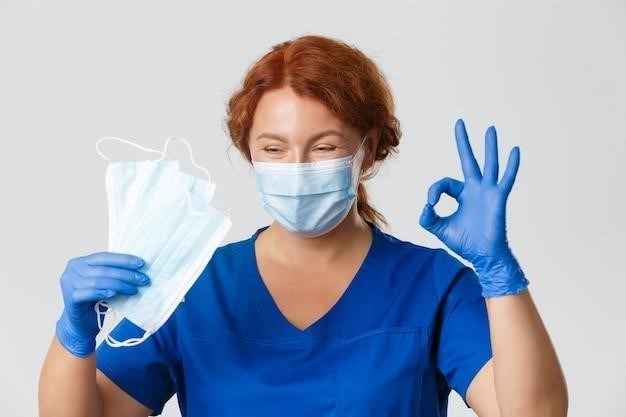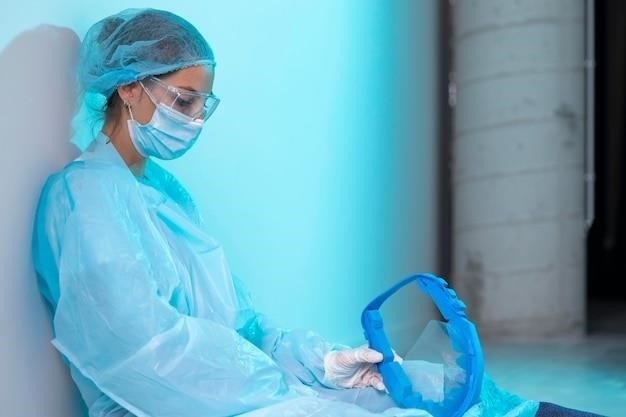Bowel Cleansing with Polyethylene Glycol
Bowel cleansing with polyethylene glycol (PEG) is a common procedure used to prepare the colon for colonoscopy or other medical procedures. PEG is a non-absorbable compound that works by drawing water into the colon, causing diarrhea and flushing out any remaining stool. This process helps to ensure that the colon is clean and clear for the procedure, allowing the doctor to get a clear view of the intestinal lining.
Introduction
Preparing for a colonoscopy involves a crucial step⁚ bowel cleansing. This process ensures the colon is clear of any stool, allowing for a clear view during the procedure. Polyethylene glycol (PEG), a non-absorbable compound, plays a key role in this preparation. It acts as an osmotic laxative, drawing water into the colon and promoting diarrhea, effectively flushing out the intestinal contents. This process is essential for a successful colonoscopy, enabling the doctor to accurately assess the health of the colon.
While the idea of bowel cleansing may seem daunting, it is a necessary step to ensure the safety and accuracy of the procedure. This guide aims to provide you with clear and concise instructions on how to use PEG for bowel cleansing before your colonoscopy. Understanding the process and following the instructions carefully will help you prepare effectively for your procedure.
What is Polyethylene Glycol (PEG)?
Polyethylene glycol (PEG) is a synthetic compound commonly used in various medical applications, including bowel cleansing. It is a non-absorbable substance, meaning it passes through the digestive system without being absorbed into the bloodstream. This property makes it ideal for bowel preparation, as it does not interfere with the body’s normal functions. PEG solutions are typically mixed with electrolytes, which help to maintain the body’s fluid balance and prevent dehydration during the cleansing process. These solutions are available both over-the-counter and by prescription.
PEG works by drawing water into the colon, increasing the volume of stool and stimulating bowel movements. This osmotic action effectively flushes out the colon, leaving it clean and ready for a colonoscopy. PEG is generally well-tolerated and safe for most individuals, although some side effects may occur. These side effects are typically mild and usually subside once the cleansing process is complete.
How PEG Works for Bowel Cleansing
PEG works by drawing water into the colon, a process called osmosis. It essentially acts as a laxative, increasing the volume of stool and promoting bowel movements. This process effectively cleanses the colon, removing any remaining stool and debris. The increased fluid content in the colon also helps to soften the stool, making it easier to pass.
PEG solutions are typically mixed with electrolytes to help maintain the body’s fluid balance and prevent dehydration. These electrolytes are essential for proper bodily functions, and their inclusion in PEG solutions helps to minimize the risk of side effects associated with dehydration. The combination of PEG and electrolytes ensures that the colon is effectively cleansed without compromising the body’s overall health.
The exact mechanism by which PEG works is still not fully understood, but it is believed to be related to its ability to attract water molecules, thus increasing the volume of fluid in the colon. This increase in volume stimulates bowel movements and helps to flush out the colon’s contents.
Common PEG Products for Bowel Cleansing
There are several commercially available PEG products for bowel cleansing, each with its own unique formulation and instructions for use. Some of the most common PEG products include⁚
- MiraLAX (polyethylene glycol 3350)⁚ MiraLAX is an over-the-counter product available in powder form that is mixed with water or a sports drink to create a solution for bowel cleansing. It is often the preferred choice due to its ease of use and generally well-tolerated nature.
- GoLYTELY (polyethylene glycol electrolyte solution)⁚ GoLYTELY is a prescription product that comes as a ready-to-use solution. It contains a combination of PEG and electrolytes, making it particularly effective for bowel cleansing. GoLYTELY is often used for same-day colonoscopy preparations.
- Trilyte (polyethylene glycol electrolyte solution)⁚ Trilyte is another prescription product that contains a combination of PEG and electrolytes. It is available as a ready-to-use solution and is often used for split-dose colonoscopy preparations.
- Colyte (polyethylene glycol electrolyte solution)⁚ Colyte is a prescription product similar to Trilyte and GoLYTELY, containing PEG and electrolytes for effective bowel cleansing. It is available in both ready-to-use and powder forms.
It’s important to note that these are just a few examples, and there may be other PEG products available. Always consult with your doctor or pharmacist to determine the most appropriate product for your individual needs and medical history.
Instructions for Using PEG for Bowel Cleansing
The specific instructions for using PEG for bowel cleansing will vary depending on the product you are using and your doctor’s recommendations. However, there are some general guidelines to follow⁚
- Follow the instructions carefully⁚ Always read the product label and follow the instructions provided by your doctor or pharmacist. This includes the amount of PEG to take, the timing of the doses, and any restrictions on food and drink.
- Start the preparation in advance⁚ Begin the bowel cleansing process several hours or even a day before your procedure, as directed by your doctor. This allows sufficient time for the PEG to work effectively.
- Drink plenty of fluids⁚ It is crucial to stay hydrated while using PEG for bowel cleansing. Drink clear liquids, such as water, broth, or sports drinks, throughout the preparation process. Avoid sugary drinks or caffeine;
- Expect frequent bowel movements⁚ PEG works by causing diarrhea, so you will experience frequent bowel movements as your colon is cleansed. It’s essential to have easy access to a bathroom during this time.
- Call your doctor if you have any concerns⁚ If you experience any unusual symptoms or have any questions or concerns about the bowel cleansing process, contact your doctor immediately.
Remember, these are general guidelines. Always follow the specific instructions provided by your doctor or pharmacist for the particular PEG product you are using.
Potential Side Effects and Risks
While generally safe, PEG bowel cleansing can cause some side effects. These are usually mild and temporary, but it is important to be aware of them. The most common side effects include⁚
- Diarrhea⁚ This is the primary effect of PEG, and it is expected. You may experience frequent, watery bowel movements.
- Nausea⁚ Some individuals may experience nausea during the bowel cleansing process.
- Cramping⁚ You may experience abdominal cramps or discomfort as your colon is being cleansed.
- Dehydration⁚ It’s crucial to stay hydrated while using PEG. Dehydration can occur if you don’t drink enough fluids. Symptoms of dehydration include thirst, dizziness, lightheadedness, and fatigue.
- Electrolyte imbalance⁚ PEG can sometimes lead to an imbalance of electrolytes in your body. This is usually mild and temporary. However, if you have any pre-existing conditions that affect your electrolyte balance, inform your doctor.
In rare cases, PEG can cause more serious side effects, such as⁚
- Bowel perforation⁚ This is a rare but serious complication that can occur if the colon is weakened or damaged.
- Allergic reaction⁚ Some people may experience an allergic reaction to PEG. Symptoms of an allergic reaction can include rash, hives, itching, swelling, and difficulty breathing.
It is essential to contact your doctor immediately if you experience any severe or unusual side effects during bowel cleansing with PEG.
Contraindications and Precautions
While PEG is generally safe for most people, there are some instances where it may not be appropriate. It’s important to inform your doctor about any existing medical conditions or medications you are taking before undergoing bowel cleansing with PEG. Here are some contraindications and precautions⁚
- Bowel obstruction⁚ PEG should not be used if you have a bowel obstruction, as it could worsen the condition.
- Severe dehydration⁚ PEG can worsen dehydration, so it should not be used if you are already severely dehydrated.
- Kidney disease⁚ PEG can strain the kidneys. If you have kidney disease, your doctor may recommend an alternative bowel cleansing method.
- Heart disease⁚ PEG can affect electrolyte balance, which may be a concern for individuals with heart disease. Your doctor will assess your individual risk factors.
- Gastrointestinal disorders⁚ If you have inflammatory bowel disease (IBD) or other gastrointestinal disorders, your doctor may recommend a different type of bowel preparation.
- Pregnancy and breastfeeding⁚ The safety of PEG during pregnancy and breastfeeding has not been established.
It’s crucial to discuss your medical history and any potential risks with your doctor before undergoing bowel cleansing with PEG. They can help determine if PEG is appropriate for you and advise on any necessary precautions.

Alternative Bowel Cleansing Methods
While PEG is a commonly used bowel cleansing agent, there are alternative methods available. These options may be considered if you are unable or unwilling to use PEG, or if your doctor deems it unsuitable for your specific situation. Some alternative methods include⁚
- Sodium Phosphate Solution⁚ This is another type of osmotic laxative, similar to PEG, but it works by drawing water into the colon through a different mechanism. It is often used for same-day colonoscopy preparation. However, it can cause dehydration and electrolyte imbalances, especially in those with kidney problems or heart conditions.
- Split-Dose Regimen⁚ This involves taking a lower dose of bowel preparation the day before the procedure and the remaining dose on the day of the procedure. This approach can be more tolerable for some individuals, as it distributes the laxative effect over a longer period.
- Combination Therapy⁚ This involves using a combination of different bowel cleansing agents, such as PEG and bisacodyl (a stimulant laxative). This can be a more effective approach for some individuals, but it may also increase the risk of side effects.
- Enemas⁚ These are solutions that are inserted rectally to cleanse the lower part of the colon. Enemas are not typically used as the sole method of bowel preparation for colonoscopy, but they can be used in conjunction with oral bowel preparation.
Your doctor will discuss the best bowel cleansing method for you, considering your medical history, any existing conditions, and the specific procedure you are having. It’s important to follow their instructions carefully and ask any questions you may have.
Bowel cleansing with polyethylene glycol (PEG) is a safe and effective method for preparing the colon for colonoscopy and other procedures. It is a commonly used method due to its effectiveness and generally good tolerability. While PEG is often the preferred method, alternative bowel cleansing options are available. It’s important to discuss your individual needs and preferences with your doctor to determine the best approach for your specific situation.
Following your doctor’s instructions carefully is crucial for successful bowel preparation and a clear visualization of the colon during the procedure. Proper bowel cleansing is essential for a safe and accurate colonoscopy, helping your doctor to detect any abnormalities or potential problems.
If you have any questions or concerns about bowel cleansing with PEG or any other method, do not hesitate to ask your doctor or nurse. They are there to provide you with the necessary information and guidance to ensure a smooth and successful procedure.
